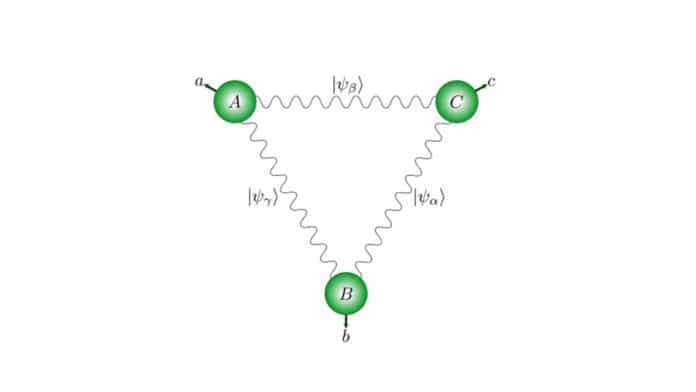Quantum entanglement is a quantum mechanical phenomenon in which the quantum states of at least two objects must be depicted about one another, even though the individual objects might be spatially separated.
What will happen if three pairs of entangled photons are placed in a network?
According to a new study, this arrangement will allow for a new form of quantum correlation in theory.
When the scientists forced two photons from separate pairs to become entangled, the connection was also made with their twin photon present elsewhere in the network, forming a highly-correlated triangle. Scientists suggest that it will create new applications in cryptography while reviving quantum physics at its most fundamental level.
Entanglement is a result of quantum mechanics that allows the properties of two or more photons. Every action performed on one of the two photons has an impact on its “twin” photon.
Nicolas Brunner, associate professor in the Department of Applied Physics in UNIGE’s Faculty of Science, said, “Quantum non-locality was discovered theoretically by John Stewart Bell in 1964. This showed that photon correlations are exclusively quantum, and so can’t be explained by conventional physics. This principle could be used to generate ultra-secure encryption keys.”
To know about the implications of this principle of quantum non-locality when several pairs of photons are placed in a network, scientists conducted an experiment, where they involved three pairs of photons that were then separated and dispersed to three points forming a triangle.
Marc-Olivier Renou, who is also a researcher in the Department of Applied Physics, said, “At each vertex, two photons from a different pair are processed together.”
Scientists subsequently forced the two photons at each vertex of the triangle to entangle by making them interact with each other, before measuring them. They finally showed that any local physical theory could not explain the statistics arising from these measurements. Also, these statistics are so strongly correlated that they could represent a new form of quantum correlations. It could become a new version of Bell’s theorem, specific to quantum networks.
Nicolas Gisin, a professor in UNIGE’s Department of Applied Physics, said, “This important theoretical discovery underlines the power of quantum correlations in networks, which far exceeds what researchers had originally thought possible. The next step will be to observe these phenomena in the laboratory. It’s not going to be child’s play, because experimenting with this is still extremely difficult for the time being.”
The study is published in the journal Physical Review Letters.
